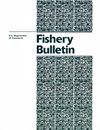Evaluating otolith increment deposition rates in bigeye tuna (Thunnus obesus) and yellowfin tuna (T. albacares) tagged in the Atlantic Ocean: Suppl. Fig. 2
IF 0.8
4区 农林科学
Q3 FISHERIES
引用次数: 0
Abstract
— A recent Atlantic- wide tag- recapture experiment run by the International Commission for the Conservation of Atlantic Tunas was an opportunity to directly validate otolith increment deposition rates for bigeye tuna ( Thunnus obesus ) and yellowfin tuna ( T. albacares ) in the region. Age and time at liberty were estimated by using annual and daily increment counts for sectioned otoliths from sampled fish previously injected with oxy- tetracycline and later recaptured. The use of annual increment counts resulted in g reater age estimates than those from daily increment counts for fish >55 cm straight fork length (SFL). Use of daily increment counts led to underestima- tion of time at liberty for fish >55 cm SFL at recovery, compared with known times at liberty. In contrast, predictions based on annual increment counts are accurate across the entire size range of sampled fish, validating the notion that increments are deposited annually. We therefore recommend that counting annual increments be the preferred method for aging yellowfin and bigeye tuna from the Atlantic Ocean and that the use of daily increments for aging be limited to young of the year. Aging fish accurately is important for stock assess- ments in which data on age and growth play an increasingly essential role in examining population dynamics. It is crucial that otolith reading practices and analyses based on age data reflect the most up- to- date recommendations for age estimation.评估大西洋大眼金枪鱼(Thunnus obesus)和黄鳍金枪鱼(T. albacares)标记的耳石增量沉积率:供应。图2
最近,大西洋金枪鱼保护国际委员会在大西洋范围内进行了一项标签重捕实验,这是一个直接验证该地区大眼金枪鱼(Thunnus obesus)和黄鳍金枪鱼(T. albacares)耳石增加沉积率的机会。年龄和自由时间是通过对取样鱼的耳石切片进行年度和每日增量计数来估计的,这些耳石以前注射过氧四环素,后来重新捕获。对于直叉长度为55 cm的鱼,使用年增量计数比使用日增量计数得到的年龄估计值更高。与已知的自由时间相比,每日增量计数的使用导致了鱼在恢复时的自由时间被低估。相比之下,基于年增量计数的预测在取样鱼类的整个尺寸范围内都是准确的,这证实了增量每年沉积的概念。因此,我们建议将计算年增量作为大西洋黄鳍金枪鱼和大眼金枪鱼老化的首选方法,并将每日增量的使用限制在一年中年轻的金枪鱼。鱼类的准确老化对种群评估很重要,因为年龄和生长数据在检验种群动态方面起着越来越重要的作用。至关重要的是,耳石阅读实践和基于年龄数据的分析反映了年龄估计的最新建议。
本文章由计算机程序翻译,如有差异,请以英文原文为准。
求助全文
约1分钟内获得全文
求助全文
来源期刊

Fishery Bulletin
农林科学-渔业
CiteScore
1.70
自引率
12.50%
发文量
76
审稿时长
>24 weeks
期刊介绍:
The quarterly Fishery Bulletin is one of the oldest and most respected fisheries journals in the world. It has been an official publication of the U.S. Government since 1881, under various titles, and is the U.S. counterpart to other highly regarded governmental fisheries science publications. It publishes original research and interpretative articles in all scientific fields that bear on marine fisheries and marine mammal science.
 求助内容:
求助内容: 应助结果提醒方式:
应助结果提醒方式:


